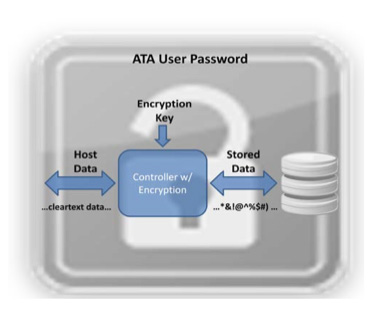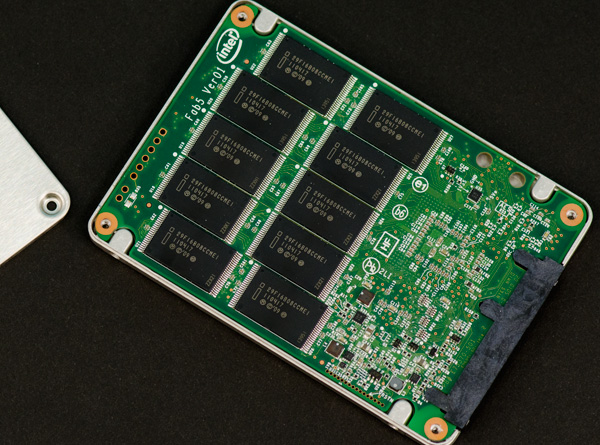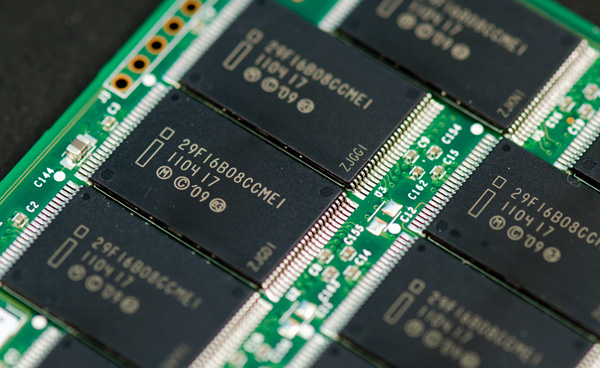The Intel SSD 320 Review: 25nm G3 is Finally Here
by Anand Lal Shimpi on March 28, 2011 11:08 AM EST- Posted in
- IT Computing
- Storage
- SSDs
- Intel
- Intel SSD 320
Spare Area and Redundant NAND
Intel's controller is a 10-channel architecture and thus drive capacities are still a little wonky compared to the competition. Thanks to 25nm NAND we now have some larger capacities to talk about: 300GB and 600GB.
Intel sent a 300GB version of the 320 for us to take a look at. Internally the drive has 20 physical NAND devices. Each NAND device is 16GB in size and features two 64Gbit 25nm 2-bit MLC NAND die. That works out to be 320GB of NAND for a drive whose rated capacity is 300GB. In Windows you'll see ~279GB of free space, which leaves 12.8% of the total NAND capacity as spare area.
Around half of that spare area is used to keep write amplification low and for wear leveling, both typical uses of spare area. The other half is for surplus NAND arrays, a RAID-like redundancy that Intel is introducing with the SSD 320.
As SandForce realized in the development of its controller, smaller geometry NAND is more prone to failure. We've seen this with the hefty reduction in rated program/erase cycles since the introduction of 50nm NAND. As a result, wear leveling algorithms are very important. With higher densities however comes the risk of huge amounts of data loss should there be a failure in a single NAND die. SandForce combats the problem by striping parity data across all of the NAND in the SSD array, allowing the recovery of up to a full NAND die should a failure take place. Intel's surplus NAND arrays work in a similar manner.
Instead of striping parity data across all NAND devices in the drive, Intel creates a RAID-4 style system. Parity bits for each write are generated and stored in the remaining half of the spare area in the SSD 320's NAND array. There's more than a full NAND die (~20GB on the 300GB drive) worth of parity data on the 320 so it can actually deal with a failure of more than a single 64Gbit (8GB) die.
Sequential Write Cap Gone, but no 6Gbps
The one thing that plagued Intel's X25-M was its limited sequential write performance. While we could make an exception for the G1, near the end of the G2's reign as most-recommended-drive the 100MB/s max sequential write speed started being a burden(especially as competing drives caught up and surpassed its random performance). The 320 fixes that by increasing rated sequential write speed to as high as 220MB/s.
You may remember that with the move to 25nm Intel also increased page size from 4KB to 8KB. On the 320, Intel gives credit to the 8KB page size as a big part of what helped it overcome its sequential write speed limitations. With twice as much data coming in per page read it's possible to have a fully page based mapping system and still increase sequential throughput.
Given that the controller hasn't changed since 2009, the 320 doesn't support 6Gbps SATA. We'll see this limitation manifest itself as a significantly reduced sequential read/write speed in the benchmark section later.
AES-128 Encryption
SandForce introduced full disk encryption starting in 2010 with its SF-1200/SF-1500 controllers. On SandForce drives all data written to NAND is stored in an encrypted form. This encryption only protects you if someone manages to desolder the NAND from your SSD and probes it directly. If you want your drive to remain for your eyes only you'll need to set an ATA password, which on PCs is forced by setting a BIOS password. Do this on a SandForce drive and try to move it to another machine and you'll be faced with an unreadable drive. Your data is already encrypted at line speed and it's only accessible via the ATA password you set.

Intel's SSD 320 enables a similar encryption engine. By default all writes the controller commits to NAND are encrypted using AES-128. The encryption process happens in realtime and doesn't pose a bottleneck to the SSD's performance.
The 320 ships with a 128-bit AES key from the factory, however a new key is randomly generated every time you secure erase the drive. To further secure the drive the BIOS/ATA password method I described above works as well.
A side effect of having all data encrypted on the NAND is that secure erases happen much quicker. You can secure erase a SF drive in under 3 seconds as the controller just throws away the encryption key and generates a new one. Intel's SSD 320 takes a bit longer but it's still very quick at roughly 30 seconds to complete a secure erase on a 300GB drive. Intel is likely also just deleting the encryption key and generating a new one. Without the encryption key, the data stored in the NAND array is meaningless.
The Test
| CPU |
Intel Core i7 965 running at 3.2GHz (Turbo & EIST Disabled) Intel Core i7 2600K running at 3.4GHz (Turbo & EIST Disabled) - for AT SB 2011, AS SSD & ATTO |
| Motherboard: |
Intel DX58SO (Intel X58) Intel H67 Motherboard |
| Chipset: |
Intel X58 + Marvell SATA 6Gbps PCIe Intel H67 |
| Chipset Drivers: |
Intel 9.1.1.1015 + Intel IMSM 8.9 Intel 9.1.1.1015 + Intel RST 10.2 |
| Memory: | Qimonda DDR3-1333 4 x 1GB (7-7-7-20) |
| Video Card: | eVGA GeForce GTX 285 |
| Video Drivers: | NVIDIA ForceWare 190.38 64-bit |
| Desktop Resolution: | 1920 x 1200 |
| OS: | Windows 7 x64 |













194 Comments
View All Comments
Ryan Smith - Monday, March 28, 2011 - link
Both the 120GB Vertex 2 and 300GB i320 are fully populated - each has all of their NAND channels in use. Intel does have a lane count advantage (10 vs. 8), but that's a design difference rather than how the SSD is populated. Thus on an architectural level it's fair to compare the controllers, as we're looking at the performance of both when they're fully populated and the architecture is not unnecessarily bottlenecked.Now at equal capacities this wouldn't necessarily be the case. Intel did not provide us with a smaller SSD, which is why Anand said "We also don't have a good idea of how much slower the smaller capacity drives perform in our benchmarks at this point.". It's safe to assume a 120GB i320 won't be fully populated and that it will have lower performance as a result. How much? We don't know.
crimson117 - Monday, March 28, 2011 - link
Thanks for the clarification! I appreciate your reply.I had missed the fact that each drive in the comparison has all its channels in use, so for example a 240GB SF-1200 would have higher capacity chips but would not have any additional channels to write across than a 120GB SF-1200.
Looking forward to the 120GB i320 review; it's much easier on the budget :)
ArteTetra - Monday, March 28, 2011 - link
i320? It sounds no good at all. Please call it with its name.GavinLeigh - Monday, March 28, 2011 - link
What we might have here is the kind of reliability (and hopefully pricing) to appeal to the notebook manufacturers. A 300Gb drive should be plenty for a road-warrior and the performance is definitely a plus over 7200rpm drives. Whole drive encryption could also add to the value in mobile applications.I think this is a smart drive, and I'll definitely consider it.
piquadrat - Monday, March 28, 2011 - link
How Full Disk Encription could add value in mobile applications when everyone can bypass ATA password within seconds using public available tools?DesktopMan - Monday, March 28, 2011 - link
See my response a page or two earlier. The password is used very differently for encrypted drives (that do cryptography correctly).tech6 - Monday, March 28, 2011 - link
While it won't win you bragging rights with your geek friends, the 320s do deliver something that has been missing from existing SSDs: Good enough performance, large capacities and reliability. The 1200 based drives had an unacceptable failure rate for most business/professional users and also couldn't deliver larger capacity drives. If the 2000 series comes in at the same price and is more reliable then Intel has problems and will need to discount but if its like the 1200 then Intel should sell a bunch of these.Chloiber - Monday, March 28, 2011 - link
I agree. The 320 is perfect for my notebook. Vertex 3 would be useless.y.a.k - Tuesday, March 29, 2011 - link
I agree. People say that it's a fail on Intel's part because it's slower than Vertex3. But I'm looking for an SSD for my work notebook, where reliability is even more important than speed. If this drive is as reliable as Intel says, then I'm getting it. And it's not like it's slow or anything.NCM - Tuesday, March 29, 2011 - link
Too many people seem to ignore that there are multiple markets for SSDs, and that they have different requirements beyond the basics. This leads to pointless discussions about the supposed merits of different SSD options. I see three main market segments, each with its own priorities:- Enterprise: Ultra high performance, and whatever you have to pay for that is simply the price of admission for your capacity and performance plan.
- Workstation: High performance boot/application drive, with the extra cost being quite moderate due to the relatively small size drive (~80-120GB) needed. Data can live on a secondary internal drive.
- Portable: Full capacity replacement for low performance standard drives. The typical single storage drive bay means that decent capacity at a reasonable $/GB is the key, not class leading performance.
(Note that reliability isn't a variable. I don't believe that any class of user will knowingly accept lower reliability than that offered by a conventional hard drive. Of course many have…unknowingly.)
This last category is the "good enough" requirement pointed out above by tech6. Sure, the Intel 320 may not be the most exciting new drive around, but notice that at $289 for 160GB or $599 for 300GB it's much less expensive than, say, the OWC Mercury Extreme at $599 for 160GB or—gasp!—$1619 for 400GB.
My own laptop drive is a 500GB with a over 300GB used, but with some housecleaning discipline I could live with the 300GB Intel. And in this application an SSD is like sex: even a bad SSD is good!
My Xserve uses an SSD boot/application drive, and I've set up one of our workstations similarly for evaluation. Boot and application launch times are, not surprisingly, 3-4 times faster with the SSD.